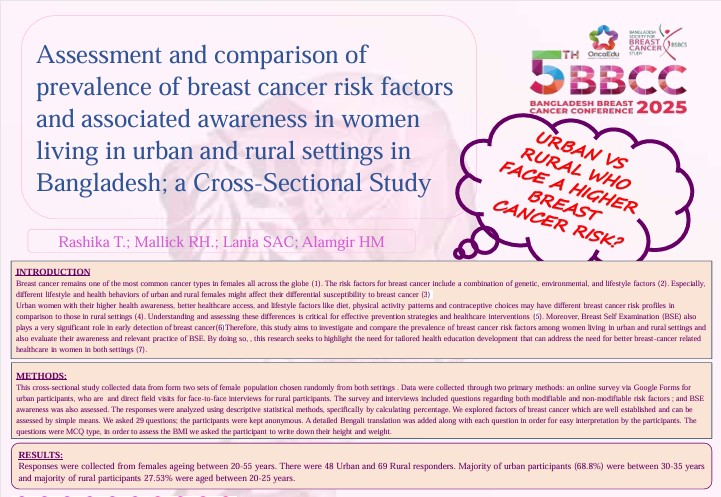Assessment and comparison of prevalence of breast cancer risk factors and associated awareness in women living in urban and rural settings in Bangladesh
Authors: Rashika T., Mallick R H, Lania S A C, Alamgir H M.
Institution: Southeast University
Introduction
Breast cancer remains one of the most common cancer types in females all across the globe (Houghton & Hankinson, 2021). The risk factors for breast cancer include a combination of genetic, environmental, and lifestyle factors (Falkenberry & Legare, 2002). Especially, different lifestyle and health behaviors of urban and rural females might affect their susceptibility to breast cancer (Fei et al., 2015) Urban areas, with their higher health awareness, better healthcare access, and lifestyle factors like diet, physical activity patterns and contraceptive choices may have different breast cancer risk profiles in comparison to rural settings. Understanding and assessing these differences is critical for effective prevention strategies and healthcare interventions. Therefore, this study aims to investigate and compare the prevalence of breast cancer risk factors among women living in urban and rural settings. By comparing these factors, this research seeks to highlight the need for tailored health education and policy development that can address the need for better healthcare in women in both settings.
Methods
This cross-sectional study aimed to assess and compare the prevalence of breast cancer risk factors and awareness among females from urban and rural areas. A random sample of females from both populations was selected for participation. Data were collected through two primary methods: an online survey via Google Forms for urban participants and direct field visits to rural areas for face-to-face interviews. The survey and interviews included questions regarding both modifiable and non-modifiable risk factors ; and associated awareness was also assessed. The responses were analyzed to evaluate and compare the prevalence of these risk factors between the urban and rural groups as well as the level of awareness in these populations.
Results
In terms of the prevalence of risk factors, women living in urban areas are more likely to have a higher BMI compared to women living in rural areas, although the difference is not striking. This can be attributed to another finding related to physical exercise, where rural women seem to be more physically active than their urban counterparts. Most importantly, the most remarkable difference between these two groups is their awareness of breast cancer risk factors. Rural women are significantly more likely to lack awareness (97.1%), whereas urban women appear to be better informed, with only 13% stating a lack of awareness. This highlights a crucial area for improvement in raising awareness in a way that effectively reaches women living in remote areas. Additionally, 92.8% of rural women are hardly informed about self-breast examination compared to 8.7% in urban areas. Another significant finding is the knowledge-action gap regarding self-breast examination. While 91.8% of urban women know some or all steps of BSE, only 10.9% actually practice it in real life.This research has taken into account the COVID-19 pandemic by examining radiation exposure resulting from diagnostic or prognostic CT scans conducted either as a consequence of the infection or for other unrelated reasons. A significant portion (8.6%) of the research population underwent CT scans at some point in their lives.
Conclusion
This study analyzes prevalence rates of different breast cancer risk factors among women in urban and rural settings . This study can be used to form targeted breast cancer prevention and awareness programs ensuring that women from all environments have proper access to the information and healthcare necessary to reduce their risk of breast cancer. Further studies can be continued to evaluate these factors using a broader sample size and longitudinal data for more comprehensive insights.
